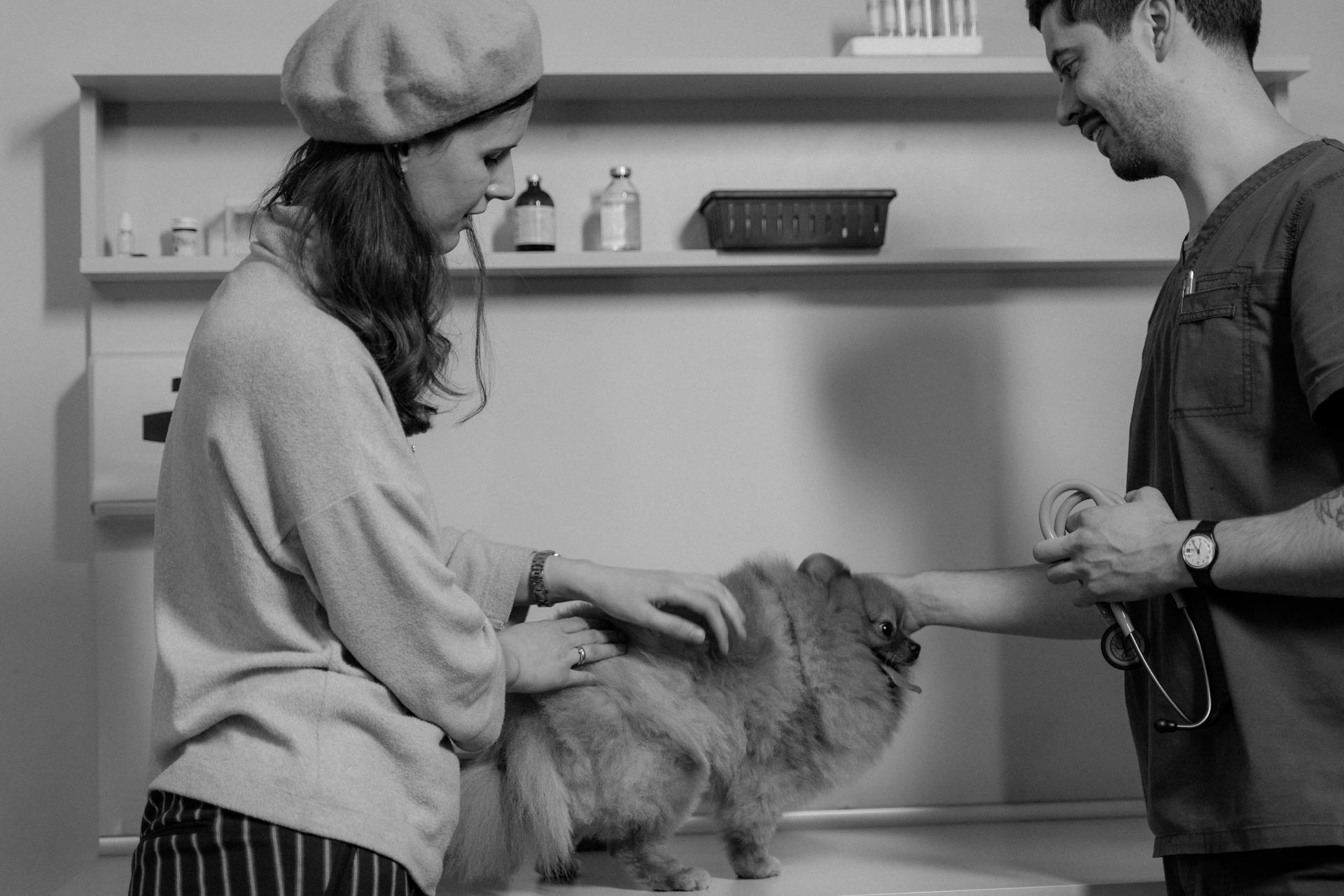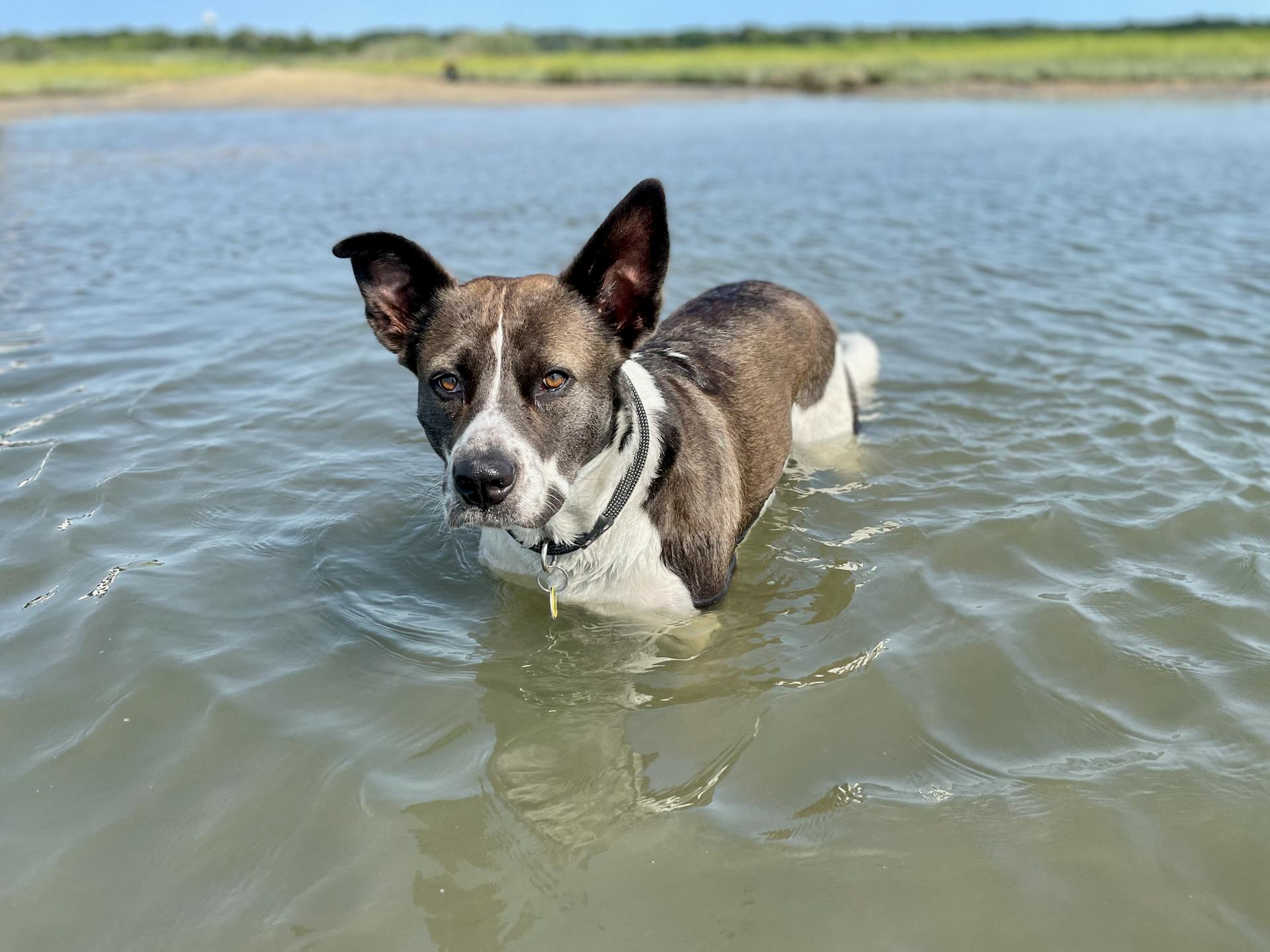
Canine hypothyroidism can cause a range of neurological symptoms in dogs, making it essential to recognize the signs and seek veterinary care if you suspect your dog is affected.
Loss of coordination and balance are common symptoms of canine hypothyroidism, often leading to stumbling or falling.
As your dog's thyroid gland slows down, it can also affect their cognitive function, leading to confusion and disorientation.
Dogs with hypothyroidism may exhibit changes in behavior, such as increased anxiety or restlessness, which can be challenging to manage.
Curious to learn more? Check out: Diabetes in Dogs
What Is Canine Hypothyroidism?
Canine hypothyroidism is a common endocrine disorder in dogs that affects their metabolism and calcium uptake.
The thyroid gland regulates these processes, and if left untreated, hypothyroidism can lead to severe neurological disorders.
Hypothyroidism is most prevalent in middle-aged and older dogs.
Screening T4 tests are included on senior wellness profiles for clinically healthy dogs to catch the condition early.
Although not curable, hypothyroidism is easily treated if diagnosed early and the dog is maintained on the recommended treatment.
The prognosis is good, and the dog's life expectancy remains normal with proper treatment.
For more insights, see: Diabetes Insipidus in Dogs Treatment Cost
Causes and Risk Factors
Canine hypothyroidism is a common condition in dogs, with most cases diagnosed in middle-aged dogs, typically around 6-7 years old. This age range is significant, as it allows for ample time to diagnose and treat the condition before it becomes life-threatening.
Data suggests that spayed females and neutered males are at higher risk of developing hypothyroidism. This is an important consideration for dog owners, especially those with pets in this demographic.
Hypothyroidism is often seen in mid to large-size breed dogs between 4 and 10 years of age, with a genetic predisposition also playing a role. While there is no known way to prevent hypothyroidism, early detection through routine wellness blood screening for senior pets can make a significant difference in treatment outcomes.
Here are some potential causes of hypothyroidism:
- Lymphocytic thyroiditis: the dog's immune system attacks the thyroid gland
- Idiopathic atrophy of the thyroid gland: thyroid tissue is replaced by fat and no apparent cause is identifiable
Is Canine Hypothyroidism Common?
Hypothyroidism is a common clinical condition in dogs.
It's one of the most commonly diagnosed endocrine disorders in dogs.
Hypothyroidism is most prevalent in middle-aged and older dogs.
This age group is particularly vulnerable to the condition.
As long as the diagnosis is made early in the course of the disease and the dog is maintained on the recommended treatment, the prognosis is good and the dog's life expectancy remains normal.
Worth a look: Dog Flea Symptoms
Possible Causes
Hypothyroidism can be caused by the immune system attacking the thyroid gland, a condition known as lymphocytic thyroiditis.
Some dogs may experience idiopathic atrophy of the thyroid gland, where thyroid tissue is replaced by fat and no apparent cause is identifiable.
A genetic predisposition for hypothyroidism is also suggested, although there is no known way to prevent it.
Risk Factors
Hypothyroidism is a common condition in dogs, affecting middle-aged dogs around 6-7 years old. Most dogs are diagnosed with hypothyroidism at this age.
Spayed females and neutered males are at a higher risk of developing hypothyroidism. This suggests that altering a dog's reproductive status may increase their likelihood of developing the condition.

A specific location of an inherited predisposition for hypothyroidism has been identified in the canine genome. This genetic factor can contribute to a dog's risk of developing hypothyroidism.
Hypothyroidism usually occurs in mid to large-size breed dogs between 4 and 10 years of age. This age range is significant, as it highlights the importance of regular check-ups for dogs within this age group.
Early detection is crucial, and routine wellness blood screening for senior pets can help identify hypothyroidism early on. This is especially important for dogs within the 4-10 year age range.
For your interest: How to Work Out Dog Years
Testing and Diagnosis
Testing and diagnosis of canine hypothyroidism can be a complex process, but understanding the steps involved can help you navigate the process with your veterinarian.
A complete blood count (CBC) and serum chemistry profile are essential initial steps in diagnosing hypothyroidism, as they help rule out other underlying conditions.
Interpreting baseline thyroid hormone levels can be tricky, as levels can fluctuate over time due to various factors.
A total thyroxin level (TT4 or Total T4) measures the main hormone produced by the thyroid gland, and a more specific blood test called a thyroid profile is often used to clarify the diagnosis.
Measuring concurrent TSH (thyroid-stimulating hormone) levels is crucial, as it helps determine if the thyroid gland is functioning properly.
TSH levels can be within the reference range in 20-40% of dogs with hypothyroidism, making it essential to monitor and retest these dogs 1-3 months later.
A normal T4 with an increased TSH may indicate recovery from a recent non-thyroidal illness or an early subclinical stage of the disease, requiring further monitoring and testing.
Here's a summary of the blood tests involved in diagnosing hypothyroidism:
- Complete blood count (CBC)
- Serum chemistry profile
- Total thyroxin level (TT4 or Total T4)
- Thyroid profile (a more specific blood test)
- TSH (thyroid-stimulating hormone)
Symptoms and Signs
Middle-aged to older dogs are typically affected by canine hypothyroidism. This age group is most susceptible to the condition.
The onset of clinical signs is gradual, with lethargy often being one of the first noticeable symptoms. Weight gain is also a common occurrence in affected dogs.
Cold intolerance is another symptom that can be seen in dogs with hypothyroidism, and it's often accompanied by dermatological concerns such as alopecia. This means that affected dogs may experience hair loss.
Neuromuscular disease is also a possible symptom, and it can manifest as vestibular signs or facial nerve paralysis. In some cases, laryngeal paralysis and megaoesophagus can occur, although a causal relationship with hypothyroidism has not been established.
Treatment and Management
The treatment of choice for canine hypothyroidism is levothyroxine.
Twice daily treatment is recommended to improve the likelihood of a positive response, especially important in a therapeutic trial.
Once stable, some dogs can be transitioned onto a once daily regime.
Absorption of the drug may be affected by food.
Clinical response should be evaluated by measuring T4 and TSH 4-6 hours post administration of levothyroxine, 6-8 weeks after starting treatment.
Related reading: Canine Cancer Treatment
Frequently Asked Questions
Can hypothyroidism cause neurological symptoms?
Yes, hypothyroidism can cause neurological symptoms, often appearing early in the disease. If left untreated, these symptoms can worsen and impact daily life.
Sources
- https://www.dvm360.com/view/hypothyroid-associated-neurologic-signs-dogs
- https://seer.ufrgs.br/index.php/ActaScientiaeVeterinariae/article/view/123247
- https://www.mspca.org/angell_services/neurologic-manifestations-of-hypothyroidism/
- https://www.ndsr.co.uk/insights/diagnosing-and-managing-canine-hypothyroidism/
- https://vetster.com/en/conditions/dog/hypothyroidism-in-dogs
Featured Images: pexels.com


